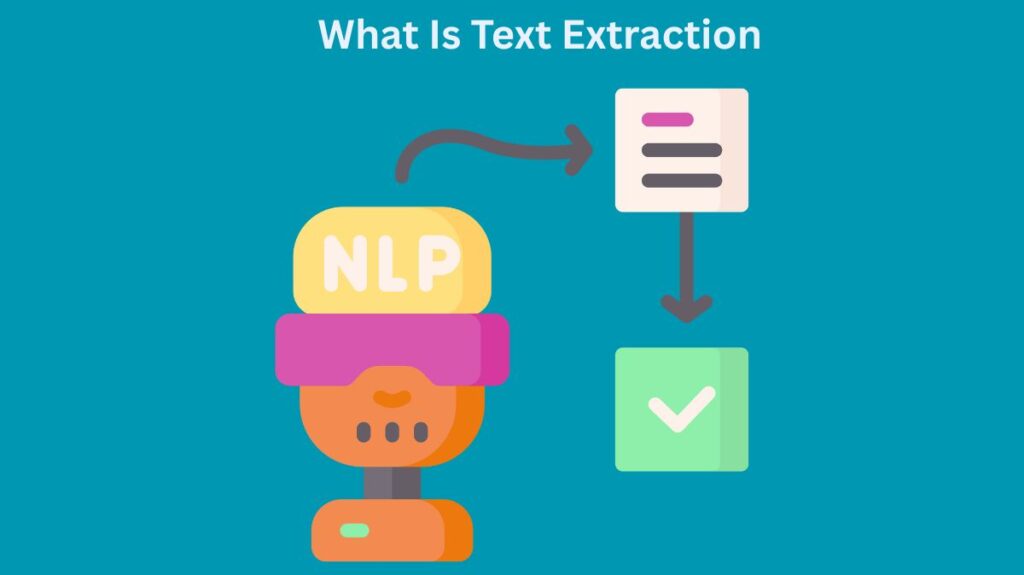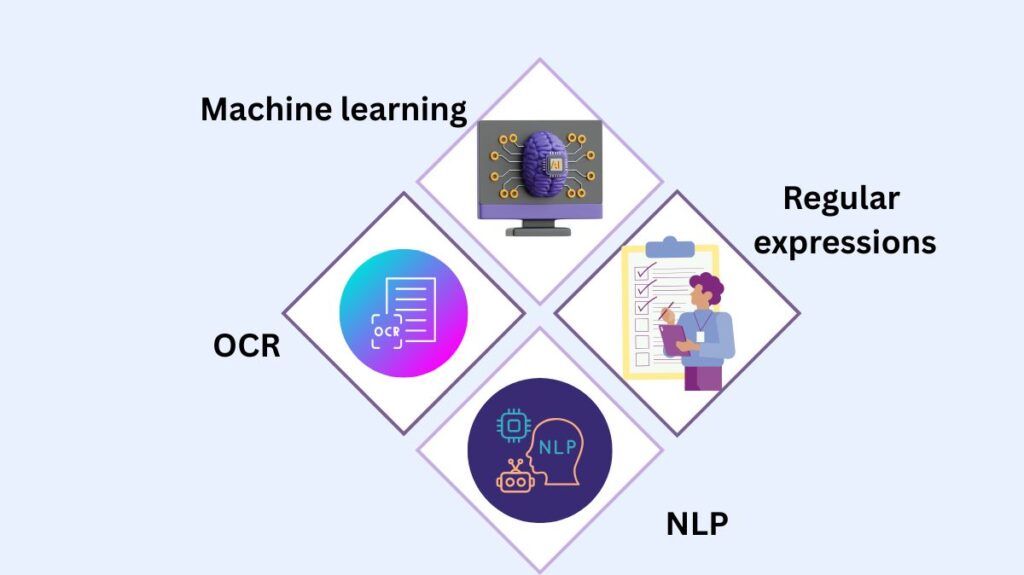Text extraction is the process of removing text from scanned PDFs, papers, or photos. It is utilize to extract insights from vast amounts of text data and is a crucial step in the data analysis process. This essay will cover the following topics: what is text extraction, Advantages, techniques, challenges and their applications, and how text extraction works.
Learn more on How Does Sentiment Analysis Work In NLP, Its Types & Levels
What is text extraction?

Every day, 2.5 quintillion (10^18) bytes of data are produced.
Businesses can get a competitive edge by using that volume of data to learn more about their clients and goods. The secret, though, is to efficiently and error-free analyze and handle such data. At this point, text extraction becomes crucial to the data processing process.
Text extraction can be done automatically using a number of text extractors, or it can be done manually by staff members reading and analyzing the content.
How does automated text extraction work?
The “Extract-load-transform (ETL)” method begins with text extraction. Finding the data that needs to be extracted is the first stage in the text extraction process. If your document is an invoice, “invoice number,” “invoice date,” “customer name,” and “table fields (description, quantity, unit price, discount, total price)” will be detected.
Text extraction algorithms use machine learning and natural language processing to extract data after identification.
Steps to summaries text extraction:
- First, the document is classified (for instance, is it a BoL document, an order confirmation, or an invoice?).
- The meta fields such as complete name, number, date, address, or price are indicated.
- Data is extracted based on predetermined criteria.
Advantages of text extraction
Effectiveness and Expandability
Information identification and analysis are two time-consuming manual processes that are automated using NLP-based text extraction.
Large amounts of unstructured text data can be handled by organizations to it, which facilitates the extraction of insights from a variety of sources, including social media and consumer evaluations.
Enhanced Precision and Cost Savings
- NLP uses sophisticated models, such as Language Models, to extract information more precisely.
- NLP minimizes errors and expenses related to manual procedures by automating tasks, hence reducing the need for human intervention.
Analysis of Data and Insights
- NLP makes it possible to extract useful information from unstructured text data, including sentiment analysis, trend identification, and consumer feedback.
- In order to aid in decision-making, it can also be used to extract particular information from financial or legal papers.
Understanding and Customising for Customers
- NLP evaluates emails, chat discussions, and customer reviews to help companies understand customers.
- Companies can personalize content and improve customer experiences by using this data.
Multilingual Capability
- Multiple language application of NLP techniques broadens the scope of applications and makes global data analysis possible.
Text extraction techniques

Text extraction methods include NLP and OCR.
Let’s examine those methods.
Machine learning
Because it can learn from examples and apply that information to additional papers, machine learning is perfect for this kind of application. This implies that you can use a machine learning model to extract information from every other document in your corpus after training it on a particular set of documents.
OCR
This entails turning text images into machine-readable text, such as scanned papers or text images displayed on a screen. OCR software recognizes and extracts text from images using pattern recognition algorithms.
NLP
NLP analyses and comprehends the text’s meaning and context through the use of algorithms. NLP algorithms extract names and dates from unstructured text.
Regular expressions
With regular expressions, particular text passages can be found and extracted from a larger body of text by applying a set of rules or patterns. To extract particular kinds of data, like phone numbers or email addresses, from a document, regular expressions are frequently utilized.
Types of NLP Text Extraction
- The Information Extraction (IE) branch of natural language processing can extract names, dates, locations, and quantities from unstructured text.
- Keyword extraction is used for information retrieval, SEO, and summarization to locate the most important words or phrases in a text document.
- Named Entity Recognition (NER) classifies textual entities like people, groups, places, and dates.
- Relation Extraction: This NLP assignment finds textual connections.
- A variety of NLP approaches are used to analyse text data and extract valuable information under the more general name “text mining.”
- Finding certain entities and their connections inside the text is known as entity extraction.
- Text sentiment analysis identifies a text’s positive, negative, or neutral tone.
- Creating a succinct synopsis of a lengthy text document is known as text summarization.
- Machine translation is the process of translating text between languages.
- Finding pertinent text excerpts to address a question is known as “question answering.”
- Analyzing a sentence’s syntactic structure to determine the relationships between words is known as dependency parsing.
- Text preprocessing includes lemmatization, tokenization, and stemming in order to clean and modify unstructured text data before analysis.
Learn more about What Are the Components Of NLP Natural Language Processing
Applications
There are several uses for text extraction across numerous sectors and domains. Typical uses for text extraction include the following:
Property
Every day, hundreds of real estate leads are sent to real estate brokers by various platforms, including Zillow, Trulia, and other websites. Automated text extraction speeds real estate transactions.
Legal and Financial
Text extraction can extract information from financial records or contracts to enhance analysis and decision-making.
Ordering and receiving food
Because data will be collected more quickly and uploaded to shared Google Sheets automatically, automated text extraction can expedite the meal delivery process. Create a DoorDash API and automate the ordering procedure for meals.
Online shopping
When you run an online business using Woo Commerce or Shopify, all of your orders will be sent to you digitally. For instance, you may use automatic text extraction to build a workflow process between HubSpot CRM and Shopify.
Challenges
- Natural language ambiguities: It might be difficult to define and extract distinct textual units due to the ambiguities that are inherent in natural languages.
- Variety of Human Languages and Writing Systems: Text extraction poses particular difficulties due to the prevalence of various languages and writing systems. Chinese text tokenization, for instance, calls for certain techniques.
- Noisy Text: It may be necessary to clean up text that comes from sources such as the internet. Programmatically extracting text from scanned PDFs is difficult.
- Finally, text extraction is a prerequisite for many NLP pipelines. It extracts raw textual material from digital sources using various methods to lay the groundwork for later processing and analysis.
Learn more about Natural Language Understanding NLU Library, NLP And NLU
